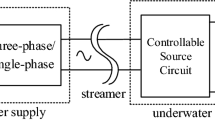Abstract
This paper presents a multi-objective design method of underwater wireless power transfer (UWPT) system for autonomous underwater vehicles (AUV) based on the cooperative design of compensation network and a DC/DC converter, considering seawater eddy current loss. Firstly, the electromagnetic field model of the underwater coil is established based on the non-axisymmetric model, and the analysis method of eddy current loss is given. Then, according to the circuit model with seawater eddy current loss, a two-port network including a compensation network and coil coupling model, is established. The cooperative design method of compensation network and DC/DC converter is presented to improve the efficiency of the UWPT system and reduce the electrical stress of the inverter, considering seawater eddy current loss. Finally, a 1 kW AUV UWPT system prototype is built. The experimental results prove that the proposed seawater eddy current loss analysis method is effective. The experimental results also show that the proposed compensation network and DC / DC converter duty cycle design method can achieve the purpose of constant voltage output, optimization of system efficiency, reduction of inverter electrical stress and inverter zero-voltage-switch.










Similar content being viewed by others
References
Askari A, Stark R, Curran J, Rule D, Lin K (2015) Underwater wireless power transfer. In: 2015 IEEE wireless power transfer conference (WPTC), pp 1–4
Assaf T, Stefanini C, Dario P (2013) Autonomous underwater biorobots: a wireless system for power transfer. IEEE Robot Autom Mag 20(3):26–32
Cheng Z, Lei Y, Song K, Zhu C (2015) Design and loss analysis of loosely coupled transformer for an underwater high-power inductive power transfer system. IEEE Trans Magn 51(7):1–10
Covic GA, Boys JT (2013) Modern trends in inductive power transfer for transportation applications. IEEE J Emerg Sel Top Power Electron 1(1):28–41
Feezor MD, Sorrell FY, Blankinship PR (2001) An interface system for autonomous undersea vehicles. IEEE J Ocean Eng 26(4):522–525
Fu M, Ma C, Zhu X (2014) A cascaded boost-buck converter for high-efficiency wireless power transfer systems. IEEE Trans Ind Inf 10(3):1972–1980
Gonçalves F, Pereira A, Morais A, Duarte C, Gomes R, Pessoa LM (2016) An adaptive system for underwater wireless power transfer. In: 2016 8th international congress on ultra modern telecommunications and control systems and workshops (ICUMT), pp 101–105
Guo Y, Wang L, Zhang Y, Li S, Liao C (2018) Rectifier load analysis for electric vehicle wireless charging system. IEEE Trans Ind Electron 65(9):6970–6982
Li S, Mi CC (2015) Wireless power transfer for electric vehicle applications. IEEE J Emerg Sel Top Power Electron 3(1):4–17
Lin MW, Li DJ, Yang CJ (2017) Design of of an ICPT system for battery charging applied to underwater docking systems. Ocean Eng 145:373–381
McGinnis T, Henze CP, Conroy K (2007) Inductive power system for autonomous underwater vehicles. In: OCEANS 2007, pp 1–5
Ramezani A, Farhangi S, Iman-Eini H, Farhangi B, Rahimi R, Moradi GR (2019) Optimized LCC-series compensated resonant network for stationary wireless EV chargers. IEEE Trans Ind Electron 66(4):2756–2765
Tejeda A, Kim S, Lin FY, Covic GA, Boys JT (2019) A hybrid solenoid coupler for wireless charging applications. IEEE TransPower Electron 34(6):5632–5645
Wang Y, Yao Y, Liu X, Xu D, Cai L (2018) An LC/S compensation topology and coil design technique for wireless power transfer. IEEE Trans Power Electron 33(3):2007–2025
Yan Z, Zhang Y, Kan T, Lu F, Zhang K, Song B, Mi CC (2018) Eddy current loss analysis of underwater wireless power transfer system. In: 2018 IEEE transportation electrification conference and expo (ITEC), pp 881–884
Yan Z, Zhang Y, Zhang K, Song B, Mi C (2019a) Underwater wireless power transfer system with a curly coil structure for AUVs. IET Power Electron 12(10):2559–2565
Yan Z, Zhang Y, Kan T, Lu F, Zhang K, Song B, Mi CC (2019b) Frequency optimization of a loosely coupled underwater wireless power transfer system considering Eddy current loss. IEEE Trans Ind Electron 66(5):3468–3476
Zhang K, Zhu Z, Song B, Xu D (2016) A power distribution model of magnetic resonance WPT system in seawater. In: 2016 IEEE 2nd annual southern power electronics conference (SPEC), pp 1–4
Zhang K, Duan Y, Zhu Z, Du L, Ren X (2017) A coil structure applied in WPT system for reducing eddy loss. In: 2017 IEEE PELS workshop on emerging technologies: wireless power transfer (WoW), pp 204–206
Zhang K, Ma Y, Yan Z, Di Z, Song B, Hu AP (2018) Eddy current loss and detuning effect of seawater on wireless power transfer. IEEE J Emerg Sel Top Power Electron 8:1
Zhang Z, Pang HL, Georgiadis A, Cecati C (2019a) wireless power transfer—an overview. IEEE Trans Ind Electron 66(2):1044–1058
Zhang K, Zhang X, Zhu Z, Yan Z, Song B, Mi CC (2019b) A new coil structure to reduce eddy current loss of WPT systems for underwater vehicles. IEEE Trans Veh Technol 68(1):245–253
Zhang Y, Yan Z, Liang Z, Li S, Mi CC (2020) A high-power wireless charging system using LCL-N topology to achieve a compact and low-cost receiver. IEEE Trans Power Electron 35(1):131–137
Acknowledgements
This work was supported in part by the Ministry of Science and Technology of China under Grant 2019YFE010020, the National Natural Science Foundation of China under Grant 51807188, and the Chinese Academy of Sciences under Grant XDA22010403.
Author information
Authors and Affiliations
Corresponding author
Additional information
Publisher's Note
Springer Nature remains neutral with regard to jurisdictional claims in published maps and institutional affiliations.
Rights and permissions
About this article
Cite this article
Liu, Z., Li, F., Tao, C. et al. Design of wireless power transfer system for autonomous underwater vehicles considering seawater eddy current loss. Microsyst Technol 27, 3783–3792 (2021). https://doi.org/10.1007/s00542-020-05168-y
Received:
Accepted:
Published:
Issue Date:
DOI: https://doi.org/10.1007/s00542-020-05168-y




